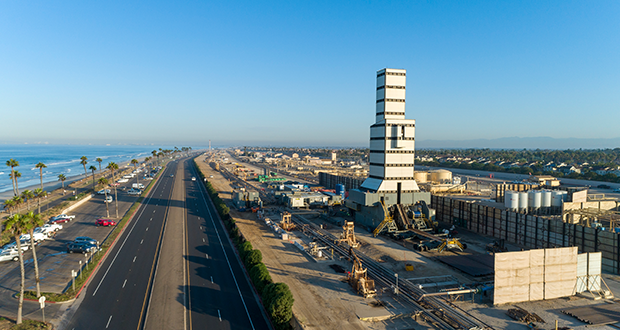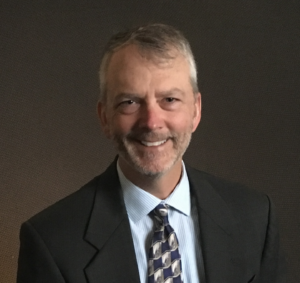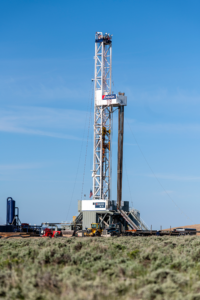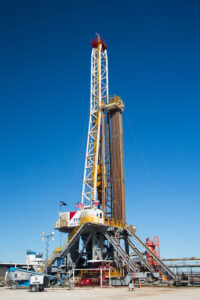Drilling industry must do more to publicize environmental stewardship, position itself as part of the solution

Ensign’s Sean Halloran: Companies also must seek ways to use growing volumes of data and extract value in real time, provide more holistic view of wellbore
By Linda Hsieh, Editor & Publisher
Sean Halloran is Vice President of Wellsite Technology for Ensign Energy Services.
Looking across your rig fleet, what do you see as the biggest challenges that you face as a rig contractor?

When we talk internally about challenges, the biggest one we’re looking at right now is this idea of climate change and how it’s affecting our business, as well as the industry in general. We recognize that shareholders want to see more of a carbon-neutral investment.
As drilling contractors, we’re really good at making holes in the ground, but we struggle a bit more when we’re asked to talk about the ways in which we are helping to reduce the carbon load.
Can you give me an idea of some of the things Ensign has done in this regard?
Back in 2013, we started a program of hybrid rigs, which are equipped with large battery energy storage systems, or BESS, along with using either natural gas or tying the rig into an electricity grid. We’ve been successful using this approach in some environmentally sensitive areas, like Wyoming, where emissions are measured and contractors have to stay within certain emissions limits. Essentially, your emissions determine the number of wells that you can drill.
This approach has proven extremely successful, but I’m not sure that we’re marketing efforts like this as well as we could be. Like I said, we’re really good at making hole, but we’re not that good at describing what we’re doing to reduce our environmental footprint.
What kind of results have you seen with this effort?
In terms of emissions reductions, we’re looking at an average of 45,000 tons of CO2 emissions that have been offset from our mix of grid-tied and natural gas hybrid rigs. That’s the equivalent of 8,600 cars taken off the road and the equivalent of having 8.7 wind turbines.
We’ve also realized significant cost savings in peak electricity costs, which can be up to 40-45% of your bill.
In certain operations, we’ve also been able to reduce the number of gen sets that are running from three to two and sometimes even just one. We can also turn off the gen sets in some instances. Altogether, this helps us to be better neighbors when we’re drilling close to or within urban centers – we’re reducing noise levels and minimizing the smell of diesel gen sets. We even have a way to mitigate light around the rig, by using dark mesh netting or by having a complete enclosure of the rig.
So it sounds like you’re doing a lot to be good environmental stewards, but your challenge is demonstrating to the public what you’re doing?
I think that we don’t necessarily talk about our greener side as much as we should. Yes, we drill mostly oil and gas wells, but we also drill carbon sequestration wells in places like Australia. Ensign also drills geothermal wells in the US and New Zealand, where the energy is being used for power generation. This is a very clean power source that our rigs are enabling.

Supplying energy is important because it provides for a better way of life, both for the end user and for the producer. At Ensign, we have demonstrated that we connect about 7% of the world’s energy needs with the source of that energy, which includes natural gas, oil and geothermal.
You know, we all live in this world. We have children and grandchildren who are growing up in this world, and we want the best world possible for all of them. We want to be a part of the solution in the climate change crisis.
I saw Shell’s very compelling presentation on their Sky scenario at an IADC conference recently. When we look that far into the future, we want to know where we fit in and what we can do to help with climate change.
Do you think the efforts you mentioned are sufficient to show the investment community your environmental steward-ship, or will drilling contractors be asked to do more in the coming years?
We have the technology to do more, but the limiter is being able to work with operators to support these hybrid rigs. Perhaps in the future, the cost savings will be compelling enough that they want to run more of these rigs. Typically, our hybrid rigs are demonstrating up to a 50% emissions reduction, and we typically see about a 20% fuel savings.
There is CAPEX involved with converting rigs to the BESS systems, but in our business today, we are still reacting from the overcapitalization of assets that happened through the boom-and-bust cycles. I think that market disruption in the form of these hybrid rigs could be a potential solution and could help to bring investors back.
Drilling contractors are rapidly adopting digital/automation technologies. What kind of “growing pains” are you encountering in this digital journey?

Ensign made the commitment seven years ago to own the brains of the rig, to own our own digital future. We decided to develop that organically, rather than take a bolt-on approach. So the growing pain we’ve experienced is that our development may not be as fast as what some of the other companies can bring to market.
However, this incremental growth has worked extremely well for our business and our goals with machine learning. For example, we started using machine learning in the cloud about five years ago. Then about two years ago, we started running those algorithms at the rig.
Today we’re using machine learning to make the driller better at what he’s doing. It’s enabling better performance and more consistency at the rig.
We’ve been able to capitalize on a small and very agile group of software developers who are also subject matter experts in our business. We find the best way forward is to pair these experts up with our experience in the field – the rig managers, the drillers and the in-house directional drillers who have years or even decades of experience.
How are technologies like machine learning changing the role of the driller on today’s rigs?
There is a change happening not just in the driller’s cabin but with the whole crew as we deploy more automation and technologies like machine learning for process automation. Initially, it frees up the driller to concentrate more on what’s important, which is the safety of his crew. Additionally, as we are able to off-load some of the tasks currently done on the rig through automation, we’re going to see that the roles on the rig will change from, say, a roughneck to more of a technician.
This is not something that’s unique to the drilling industry. We see this across most industries when it comes to automation. There’s always this perception that automation reduces the number of people needed for a certain task. In most cases, that’s not really true. What it changes is the role of the people participating in that task. The roles are typically high graded.
Whereas as you would have a labor role before, like a roughneck, the entry-level role might become a hydraulic technician. You might find that you don’t need a full-time guy to dope the threads and pull the slips, but you need a full-time guy doing hydraulic work, maintenance and monitoring – and every now and then, they have to work as a roughneck.
The driller becomes more of a quarterback, or a manager on the rig, instead of standing out on the floor with his hand on the brake handle. The driller is now making sure that set points are correct, that the data he sees coming back from the well and from the machines are all in line with expectations. He’s spending more time ensuring the state of his crew and ensuring the safety of the well during the well construction process.
We’ll continue to see that evolve over the coming years.
Can you talk more specifically about how you’re using machine learning to help the driller in his job?
If you look at the typical data stream that a driller sees while drilling through a stand, you’re looking at ROP, which is a noisy measurement. It’s going up and down as it’s encountering different downhole conditions. We’re able to pull out of that ROP mode and start looking at mean specific energy (MSE), which is the amount of energy required to remove a unit volume of rock and get it to the surface. It’s a very normalized way of looking at how much energy it takes to drill.

So if we shift our emphasis to MSE and can see changes there, we can identify, for example, moving through a formation change, or is there something happening downhole like bit balling, stick-slip or interfacial severity? All of these things have signatures, and machine learning can pull the data out of the noise and identify the root cause of MSE shifting upwards, whether it’s bit disfunction or if we’re simply transitioning through a formation change. That allows the driller to really understand how he should be responding to these very noisy signals.
In essence, instead of just looking at ROP, now you have a more holistic view of what’s happening. You get more information, which is enabling better decision making in real time.
What are some of the challenges you encounter in making better use of data at the rig site?
The challenges lie in figuring out clever ways to use big data in real time rather than offline.
I’ll give you an example. Five years ago, when we started installing historians on our rigs to stream data in real time to our corporate cloud, we were able to run queries across all of our rigs to produce results. We could do that fairly quickly.
Fast forward to today, where we have terabytes of data for all of our rigs. We have to be cleverer with how we’re caching and how we’re partitioning the data in order to get the same real-time results that we want to see, yet still take advantage of the large data sets. And, of course, the more data you can feed into your machine learning analytical techniques, the better results you get. So we are constantly looking at new technologies that are coming out in the cloud, whether it’s Amazon or Microsoft or Google or whoever is coming up with new ways of dealing with these large data sets and streaming data.
We look a lot at data in motion, which is the real-time data that’s being produced every millisecond and streaming off the rig. We want to use that real-time data where we don’t have to manipulate it too much. We don’t have to put it into a database and copy it to a table and then run analyses on it, and then put it into another table to be used by the HMI to visualize what’s happening. We’re able to use newer technologies to grab that data in motion, clean it, use it in the machine learning, and then visualize the results directly.
At the same time, we’re also looking at data at rest. This can be, for example, the well plan and the formations that we’re going to be drilling through. We need to be able to access this static data in conjunction with the data in motion. We’re constantly trying to improve our abilities there, too.
So you’re borrowing a lot of technologies from Silicon Valley?
Absolutely. There’s a very fast turnaround on some of these web-based technologies in other industries because they can take more risks than we can. A failure for them may be just an inconvenience. But if we get stuck in a well, there are millions of dollars on the line or, in a worst-case scenario, there could be a safety issue.
So we let them take the chance for us and do some of the heavy lifting in developing these technologies. When we see a technology transition into more mission-critical applications, like vehicle navigation automation, then we can start to run it through our lab and simulations and see how we can apply it on our rigs.
How can drilling contractors evolve business models that would allow them to have a bigger share in the value they create for operators through improved efficiency?
I’m a big proponent of the performance-based business model that’s being driven by some of these new technologies.
Most operators today are realizing a twofold or more increase in the footage that they are drilling in the same amount of time compared with just a couple of years ago. That’s a clear performance increase that we’ve delivered to the operators, but dayrates haven’t changed that much in the last four years.
We would like to take part in a collaboration with the operators where the benefits are realized on both sides. Being a contractor that just rents their rigs on a dayrate basis is probably not going to drive the kind of returns we need to sustain the industry. We really need performance contracts to become the norm where we’re both able to participate in the gains, as well as the risks.
Would you like to see any changes in how operators measure the performance of a rig or contractor?
I think it’s evident that drilling contractors have already delivered a lot of performance. What we would like to do is turn the conversation to consistency.
We have certain applications to help with that, and I’m thinking along the lines of process automation, slips-to-slips automation, and the kind of ROP optimization where we’re able to deploy machine learning to adjust the ROP as we drill through different formations.
The consistency we can deliver through that approach, I think, is really what the operators want to lock in, and that’s really where I think they will want to measure.
Performance is already excellent right now – we’ve already delivered that. We haven’t seen anybody complain about not drilling fast enough. Now it’s all about consistency. How do we get the data consistency and quality back to the operators? The conversations are really changing around this.
At Ensign, we’ve seen very positive results from our collaborations with customers. I’ll give you a good example of this from 2018, when one of our customers in Texas had a new, very aggressive bit design.
They wanted to see a narrow but very high window for weight on bit – a minimum of 45,000 lbs and maximum of 60,000 lbs. That’s not too far out of the norm, but the twist came when they said, “We need this to operate at least 1,000 feet an hour.”
Going that fast through a formation with that kind of weight on bit, you can get some very fast transient responses where you’re close to moving out of control. On top of that, they wanted plus or minus 5% on weight-on-bit deviation.
By working together in a way that shared both the gains and the risks, ultimately we were able to deliver on what they asked for.
We’ve talked a lot about digital, automation and software. On the iron side, what do you see as the key considerations for drilling contractors for the next generation of rigs?
When I started at Ensign in 2014, we were in the middle of a $1 billion rig build campaign. That was exciting, and we were able to take advantage of that to build out our operating system.
But now the capital constraints of the industry are really not going to allow a new rig build cycle to take place anytime soon. In addition, dayrates are not supporting some of the interesting concepts we’ve seen for highly robotized or highly automated rigs.
If I look at this from the hardware side, I think one of the key considerations is just going to be dayrate. Dayrate has to increase if we are going to move beyond the current rig design.
Further down the road, we really do need to remove all people from the drill floor. We need to get there, and we’ll need an increase in dayrates to get there.
Hopefully, the operators will collaborate with drilling contractors to make that a priority when we move into the next rig build cycle. DC





